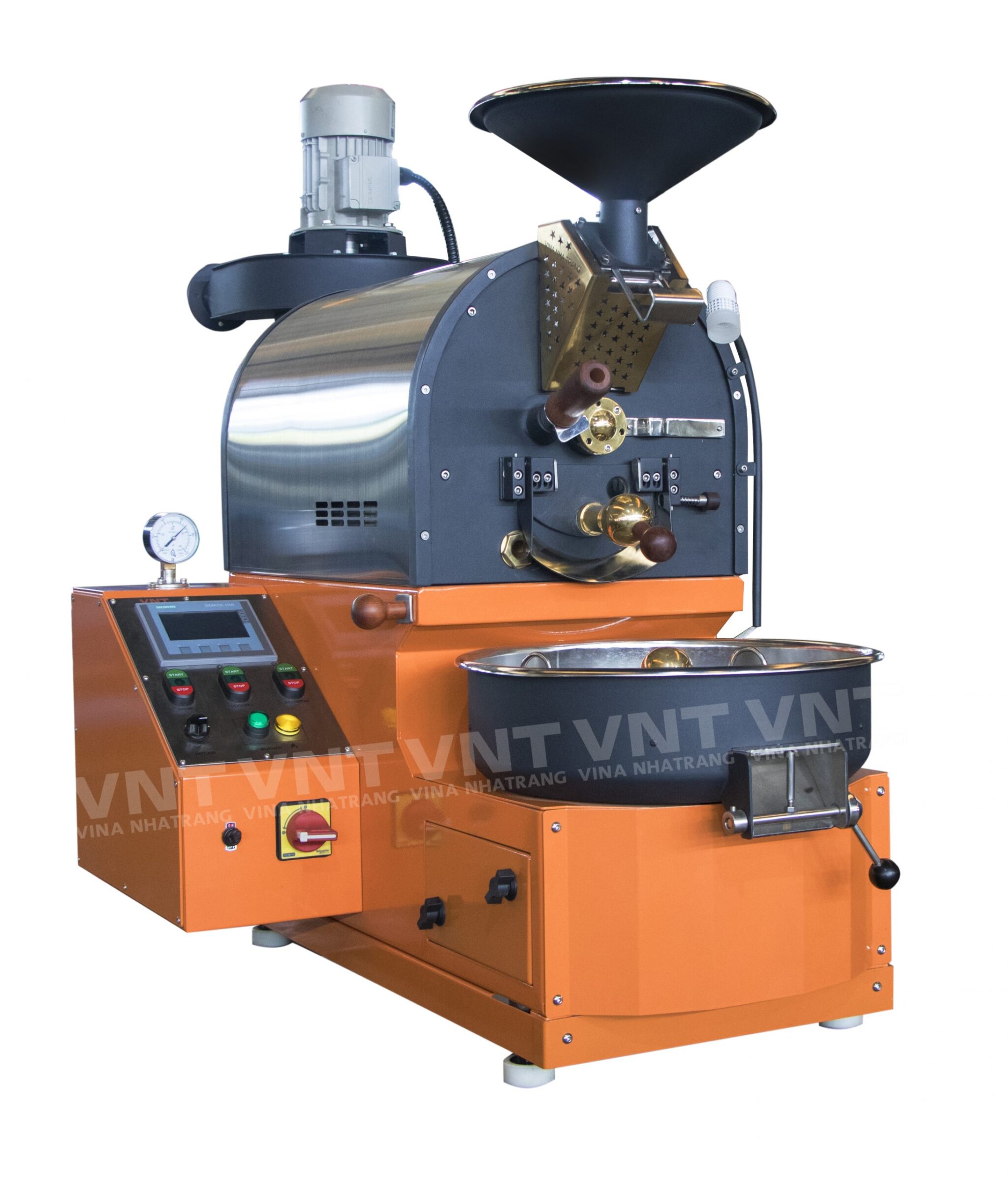Properly maintaining commercial coffee roasters is crucial for ensuring consistent coffee quality, maximizing equipment lifespan, and preventing potential safety hazards. Neglecting regular maintenance can lead to subpar roasting results, inefficient operations, and even catastrophic equipment failures. This comprehensive guide will walk you through the essential steps for maintaining your commercial coffee roaster, enabling you to consistently deliver exceptional coffee while safeguarding your investment.
Type of Coffee Roasters
Before diving into the maintenance specifics, it’s essential to understand the different scales of coffee roasters and their respective capacities.
- Commercial coffee roasters are designed to handle batch sizes ranging from 1kg to 30kg, catering to the needs of cafes, micro-roasteries, and small-to-medium-sized coffee businesses. These roasters strike a balance between output and footprint, allowing for efficient roasting operations without occupying excessive space. Whether you’re working with a 5kg drum roaster or a 20kg fluid bed roaster, the maintenance principles remain largely consistent, with adjustments made for the specific roaster size and configuration.
Explore more: Best Commercial Coffee Roaster for Small Cafes & Restaurants
- On the other hand, industrial coffee roasters are built for high-volume production, typically handling batch sizes between 30kg and 60kg. These behemoths are the workhorses of large-scale roasting facilities, supplying coffee to supermarkets, restaurants, and other high-demand outlets. While the fundamental maintenance tasks are similar, industrial roasters often incorporate more complex systems and components, requiring specialized expertise and equipment for servicing. Additionally, the sheer scale of these roasters necessitates more stringent maintenance protocols to ensure consistent performance and mitigate potential safety risks associated with handling larger batches.
Explore more: Industrial Coffee Roaster: Everything You Need to Know
No matter how big or small your roaster is, it’s important to know its details, how it works, and what the maker suggests for maintenance. This helps you make a good plan to take care of it properly. By matching your maintenance with how the roaster is made to be used, you can make sure it works well, lasts long, and makes great coffee. In this blog post, we’ll talk about how to maintain commercial coffee roasters that can operate between 1kg and 30kg of coffee beans.
Maintain your Coffee Roaster: Step-by-step
Step 1: Understanding your Coffee Roaster
Crafting exceptional coffee begins with an intimate understanding of your commercial roaster – from the humming of the drum to the swoosh of the cooling tray. Observe your machine scrupulously and learn the rhythm of its operation. A deviation in sound or roast quality can signal a need for maintenance. Establish a consistent plan:
- Familiarize yourself with individual components and their maintenance requirements.
- Stay vigilant for any indicators of malfunction.
- Maintain a schedule for servicing and cleaning to prevent debris accumulation, which can mar both taste and efficiency.
- Calibration is the pulse by which quality is measured; ensure this is done frequently.
- Continuously educate yourself on advances in roasting technology to enhance your machine’s capabilities and its operational lifespan.
By developing an intimate understanding of your roaster and its unique rhythms, you safeguard the quality of your coffee and the integrity of your investment, allowing you to conduct the symphony of flavors with unwavering precision.
Step 2: Daily Maintenance
A daily cleaning ritual is an absolute must, for even the slightest residue or debris can compromise the integrity of your roaster’s performance and the quality of your finished product. Approach this task with reverence, for it is a sacred rite that upholds the sanctity of your craft.
- Clean the Roaster: Before and after each time you roast coffee beans, carefully clean the roaster. This helps stop coffee oils from getting hard and blocking airflow, which can mess up how evenly the beans roast and might even be unsafe.
- Empty the Chaff Collector: Keep the chaff collector empty regularly. If it gets full, it could block the airflow in the roaster, making it harder for the beans to roast properly.
- Keep the Cooling Tray Clean: Use a vacuum to clean the cooling tray often. This helps the beans cool down quickly and evenly, keeping their quality intact.
- Check for Foreign Objects: Look inside the roaster before and after you use it to make sure nothing foreign is in there. Even a tiny thing can mess up how the beans roast.
- Clean the Sieves: Pay close attention to the sieves and clean them well to prevent anything from clogging them up. If they get clogged, the airflow won’t be as strong, which can make roasting uneven.
- Use Compressed Air: Sometimes, use compressed air to clean the roaster’s deck and filters. This deep cleaning keeps the roaster working well without any dirt or buildup.
Each step shows how committed you are, making sure every batch of beans gets the best treatment. This leads to a better cup of coffee for your customers who have a good taste.
Step 3: Weekly and Monthly Maintenance
Weekly and monthly maintenance routines are the preventive measures that fend off sudden malfunctions in commercial coffee roasters.
- Deep Cleaning: Once a week, do a thorough clean-up. Use special tools and methods to get rid of stubborn coffee bits that regular cleaning might miss. This big clean-up helps keep the airflow good and stops stuff building up that could make your roaster not work as well.
- Check Mechanics: Look closely at all the mechanical parts of your roaster. See if anything looks worn out, loose, or broken. Doing this helps you fix small problems before they become big ones.
- Inspect Every Part: Take a close look at all the important parts of your roaster, like the drum and burner. Check for any signs of damage or wear. This careful check-up makes sure your machine is working its best.
- Replace Parts Early: Don’t wait for things to break. Replace any parts that look like they’re wearing out before they cause problems. This keeps your roaster running smoothly and prevents it from breaking down.
- Check Sensors and Gauges: Test and adjust the sensors, thermometers, and gauges on your machine regularly. This makes sure they’re giving you the right information so you can roast your coffee beans just right every time.
- Keep Records: Write down everything you do to maintain your roaster in a log. This helps you keep track of how well your roaster is working and lets you see if there are any patterns or problems you need to fix. It’s a good way to make sure your roaster stays in good shape for a long time.
By sticking to this steady schedule of weekly and monthly upkeep, you create a great environment where all parts work together perfectly to make the best roasted coffee. This shows how dedicated you are to your job and how much you want every cup to be perfect.
Step 4: Seasonal and Annual Maintenance
Just like how nature changes and brings new life each season, your commercial coffee roaster needs regular care to keep working its best. This means doing maintenance tasks every season and year, like a special ceremony, where you carefully check and refresh all the important parts of your roaster.
- Overall Maintenance: Once a year, give your roaster a thorough check-up. Replace any old parts, update the software, and adjust settings to keep it working its best.
- Thorough Part Check: Look closely at important parts like gaskets, sieves, belts, chains, and bearings for any signs of wear or damage. Notice that it’s important to replace certain parts, like damping rubbers, every 18-24 months to keep things running well. Replace anything that’s not working right to keep your roaster running smoothly and making good coffee.
- Cleaning the Roasting Chamber: Scrub and check the roasting chamber and exhaust system carefully to get rid of any built-up dirt. This deep cleaning helps make sure your roaster works like new.
- Temperature Control Check: Making sure your temperature sensors and controls are set right isn’t just a suggestion – it’s really important for getting the same great results every time you roast. Take the time to make sure these systems are working correctly.
- Review Maintenance Records: Look through your maintenance records carefully to see if there are any trends or signs that parts might be wearing out. This helps you plan ahead and avoid unexpected breakdowns.
Dedication to these periodic check-ups can significantly extend the life of your roaster and enhance its reliability.
Step 5: Professional Maintenance and Servicing
Even with your dedicated regular maintenance, there comes a time when the skills of professional technicians are needed. These experts go beyond what in-house maintenance can do, performing thorough inspections, precise adjustments, and complicated repairs with expert accuracy.
Think of scheduling professional servicing not as a chore, but as a chance to make your roaster perform even better. Trust these skilled technicians to handle your machine at the recommended times. They have special tools and equipment that can uncover hidden issues and details that might go unnoticed otherwise.
The benefits of professional maintenance:
- Longer Lifespan: Professional technicians, with their attention to detail and deep knowledge, can spot and fix potential problems early, making your roaster last longer and protecting your investment.
- Improved Efficiency: With their understanding of how your roaster works, these experts can adjust systems to make sure it runs as efficiently as possible, saving energy and reducing costs.
- Preventing Breakdowns: By drawing on their experience, professional technicians can predict and prevent breakdowns, giving you peace of mind and avoiding costly downtime that could disrupt your business.
Think of professional maintenance and repair as an essential part of taking care of your roaster. Just as a master musician trusts a skilled craftsman with their instrument, you should trust these highly trained professionals with your roaster. Their expertise is the finishing touch on your masterpiece, ensuring that every batch of coffee is of the highest quality and consistency.
Tools Needed for Maintenance
To execute the sacred maintenance rituals outlined above, you must arm yourself with the proper tools – a curated collection of specialized instruments designed to enhance your roaster’s performance and longevity. These tools are the extension of your reverence for the craft, enabling you to tend to your machine with precision and efficacy.
- Vacuum Cleaner: A strong vacuum cleaner is really useful for getting rid of leftover bits of coffee chaff and dirt. With this tool, you can carefully clean the airflow system to make sure air can flow smoothly and your coffee roasts evenly.
- Specialized Exhaust Cleaner: Get a good exhaust cleaner designed specifically to clean the buildup that happens in your roaster’s exhaust system over time. Using this cleaner helps your roaster work well and keeps it safe.
- Electrical Tester: Having a reliable electrical tester is super important for checking and fixing any problems with your roaster’s electrical parts. This tool helps you find and deal with issues quickly, so your roaster keeps working right and you don’t have to spend a lot of money on repairs.
- Calibration Tools: Precision is really important when you’re roasting coffee, so you need good calibration tools to make sure your roaster’s thermometers, gauges, and monitoring systems are giving you accurate information. Invest in good-quality calibration tools to make sure your coffee turns out consistently great every time.
- Comprehensive Toolkit: Put together a toolkit with all the tools you need for maintenance tasks, like wrenches, pliers, screwdrivers, and more. Having these tools on hand lets you do lots of different maintenance jobs, from tightening bolts to replacing parts and fixing small problems.
- Safety Kits: Ensure safety is paramount. Don’t forget to wear safety goggles, heat-resistant gloves, a face mask, and non-slip shoes when performing maintenance tasks.
These tools are not mere implements but rather extensions of your dedication, enabling you to tend to your machine with the utmost care and precision, ensuring that every cup of coffee you produce is a masterpiece.





